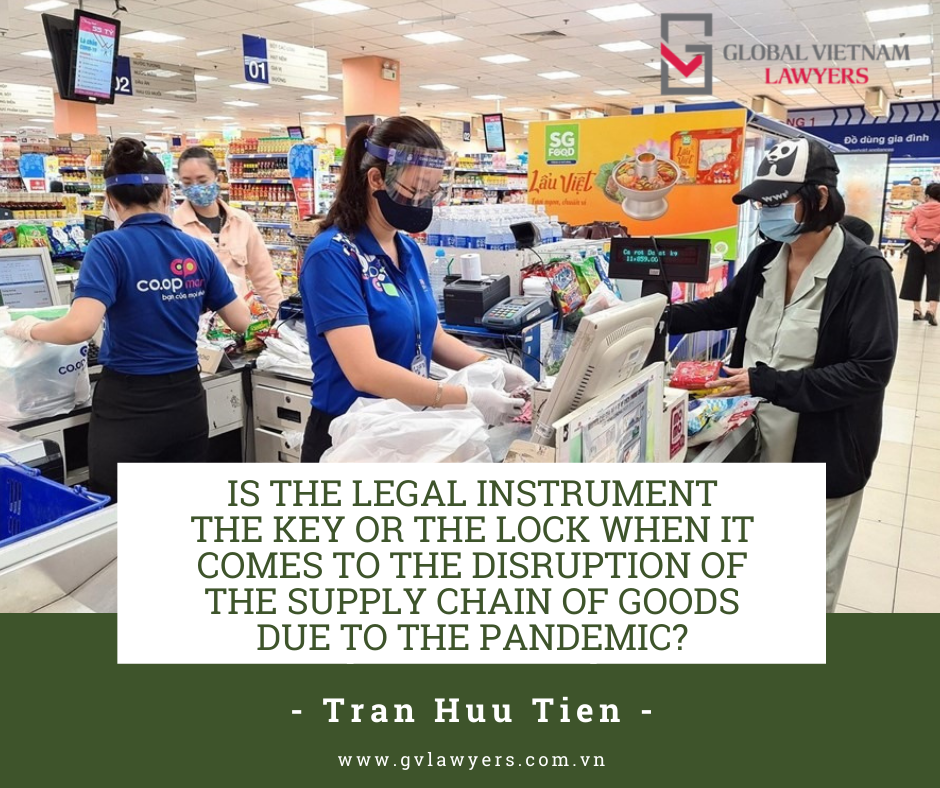GV Lawyers would like to introduce you an article by Lawyer Tran Huu Tien titled “Is the legal instrument the key or the lock when it comes to the disruption of the supply chain of goods due to the pandemic?” was published on the Vietnam Lawyers Electronic Journal on 26 August 2021.
***
(LSVN) – The past days have witnessed many localities, including the leading economic centers of the South, restrict almost all activities to implement social distancing against the pandemic. Goods either slow down or come to a standstill. Markets, commercial centers, supermarkets… alternate between lockdowns and openings. Each piece of meat, each onion, and each bundle of vegetable become strangely precious.
Difficult situation of the supply chain of goods
You do not need to be an economic expert to see that before the Covid-19 pandemic, there has never been any risk that posed so many challenges to Vietnamese goods suppliers. Customers hesitate in every transaction, from micro to macro. Previously effective and diverse distribution methods have been narrowed down into two basic channels: “delivery” and “sell at essential stores”. But these channels are not always able to operate effectively. Goods get stuck at ports or warehouses; or if you can get through at one station, you might still get stuck at another station as a particular locality is too careful. The common scenario is that revenue goes down, income declines, most importantly, cash flow slows down, while the burden of costs (facilities, raw materials, taxes, fees, labor, …) looms in the books. A thousand and one reasons why business managers have a headache upon solving business problems during the pandemic.
While bearing many things, businesses also need to care about the health of employees upon maintaining production and business, because whether one likes it or not, the health of employees is the very “health” of the business. Initiatives have been raised such as dividing working groups, a 2- destination route, 03 on-site activities, then 02 on-site activities… but there is no comprehensive plan for ensuring 100% of operation capacity. Failure to operate properly also means that businesses are neither autonomous in fulfilling orders, nor capable of self-determination in transactions. Breaking commitments is the last option considered.
But once made, this decision will not just be about commitment or credibility – which is a measure of business success or failure, but also the breakdown of partnerships in the supply chain. Loss of source of goods, loss of output – disputes may occur. But as the pandemic is a “cannot-be-more reasonable” ground to justify and the dispute resolution methods are almost frozen (Courts, arbitration bodies, conciliation are forced to limit their activities), not every enterprise has the patience (and ability) to stay maintained until the problem is resolved. Once things get out of hand, enterprises falter at a 2-way junction—to be or not to be.
Enterprise is the most important element, the breath of the supply chain. The supply chain will “lose power” if that element fails. Vietnam is perhaps has been witnessing the most depressive phase of the supply chain in recent years.
The report of the General Statistics Office recorded that in the first 7 months of 2021, nearly 80,000 enterprises stopped doing business and were dissolved across the country. This number increased by more than a quarter compared to the same period in 2020. Many businesses (mostly small and medium enterprises) have not been able to overcome the fierce pandemic wave. The key role is pushed to the shoulders of the “big guys” with enough force and scale to shoulder. But that is just a slim choice in the context of “no one dares to predict anything” in the midst of the pandemic…
A company supplying pork products, the second largest of the South, suddenly announced the possibility of temporarily suspending supply to Ho Chi Minh City because of some internal infection cases. Although the problem has been resolved in time, this is an illustration of how the product supply chain can be dependent and fragmented due to the impact of the pandemic. The risk of a local crash is real if the supply is not properly protected. The consequences of this are hard to imagine, but the hardest hit are certainly businesses and consumers.
The leading role of the State’s legal instrument in solving supply chain difficulties
In a difficult situation, businesses expect help from the government so that they do not have to continue “groping in the night”. Just as patients need oxygen when their illness worsens, this is a critical time for the government to put the most suitable “ventilators” for a supply chain that is facing too many risks. The “ventilator” here is the legal instrument that the State needs to soon put out to intervene and cure.
Responding to the development of the pandemic, the Government has taken urgent but very careful measures and actions to solve problems that arise from time to time. Directive 16/CT-TTg dated 31 March 2020 of the Prime Minister on the implementation of urgent measures to prevent and control the Covid-19 epidemic clearly shows that people are allowed to go out to buy food and eatables, necessities and these goods are also allowed to move to ensure people can access during social isolation.
As a few localities, due to their lack of experience upon fighting the epidemic for the first time, were still fumbling about how to absorb and explain the spirit and policies of the central government, the Ministry of Industry and Trade issued Official Letters No. 4349/ BCT-TTTN and No. 4481/BCT-TTTN on 21 and 27 July 2021 respectively, agree to identify essential goods and services to allow circulation throughout the country when implementing the Directive. No. 16/CT-TTg. The above documents are considered “a shower against drought comes in the nick of time” for businesses that supply essential products. Escaping from the fear that the movement of essential goods may be blocked at any time, businesses have rested assured to operate the wheels to move goods from the place of production to the place of distribution.
Also from the spirit of welcoming the opinions of people, businesses as well as industry associations, agencies and branches have actively coordinated to give practical guidelines to ensure goods are circulated, handled the situation of congested or branched goods. Proposed initiatives such as “green channel” for transport, application of technology in traffic control, exemption from internal inspection, etc. have been actively absorbed and developed. State documents are continuously released for the purpose of coordinating and implementing those policies (Dispatch No. 5187/VPCP-CN dated 29 July 2021 of the Government Office, Official Letter No. 1015/TTg- CN of 25 July 2021 of the Prime Minister, Official Letter No. 5753/BYT-MT and No. 5886/BYT-MT of July 19 and 22, 2021 of the Ministry of Health, Official Letter No. 7630/BGTVT-VT dated 27 July 2021 of the Ministry of Transport, Official Letter No. 5222/TCDBVN-VT dated 25 July 2021 of the General Department of Roads…), proving that the State has been focusing all its attention on dual goals.
Initial doses of drugs are being introduced into the supply chain symptomatic treatment, and they are working. Ways to strengthen resistance and help businesses stand firm such as tax exemption and reduction, social insurance payment reduction have also been considered and implemented. These include Resolution No. 30/2021/QH15 dated 28 July 2021 of the National Assembly, Notice 209/TB-VPCP dated 05 August 2021 of the Government Office, Resolution 68/NQ-CP dated 01 July 2021 of the Government, Decision 23/2021/QD-TTg of 07 July 2021 of the Prime Minister. There were certain joys in spite of many worries. All of that affirms the great role of the State’s legal instrument in the goal of protecting the supply chain of goods, in addition to the efforts of businesses and people.
The epidemic is now unpredictable, the fight against it stays still arduous. To bring the economy in general and the supply chain of goods in particular back to the inherent pace will be a long and thorny journey. Unravelling and solving difficult problems at each moment, in addition to acute and direct measures, businesses tend to expect more comprehensive and long-term State legal instruments such as general plan, action program, or even law (for example, disaster management law as some countries around the world apply)… Therefrom, the business itself can rely on to develop a business plan, its own response. As a result, the government and businesses can have a thorough consensus in the implementation of common orientations and policies. From a cautious perspective, the government also needs to be clever and flexible in building legal instruments to achieve optimal results, avoiding unwanted “side effects”.





